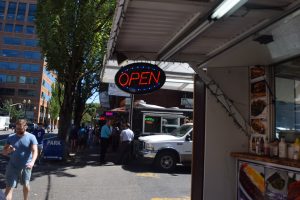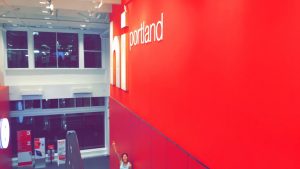Portland 1
The concept of “place” refers to the ideas, characteristics and perceptions people associate with certain geographical areas or people in these geographical areas. These can be physical, in terms of landmarks and features of the earth, or human, in terms of religion and culture. However, for some, a certain place can hold a more personal meaning, as it is associated with feelings of belonging and comfort. This can be in the form of sights, smells, sounds, memories, or even people. At the moment, I am on the University of Richmond campus participating in summer research. For outsiders, UR would be matched with statements such as “near the James River,” “in the forest,” “liberal arts,” “good basketball team,” or “academically challenging.” However, for me, as someone who has stayed here for most of the past year, it translates to more than that. While all those stereotypes of UR by outsiders may be true, my sense of place here is more in-depth, as the characteristics that make this place unique for me have fostered a sense of personal attachment.
When I think of the City of Portland, I associate it with being rainy and somewhat overcast and housing very hippie people in a very environmentally conscious area. These stereotypes were reiterated by the introduction of this book. However, I did not know that, although liberal overall, there are certainly areas around Portland that are more conservative. Additionally, I was surprised to find that Portland has more breweries than any other city in the world or that the place has experienced a recent boom in food cart population. I had always just linked it with really good coffee.
The authors chose to introduce Portland as a Casacadian City because they hope that most people, especially people reading this book, do not have a preconceived notion of what that means. They state that there are “many standard ways of framing Portland as a place,” such as a place in Oregan, the West Coast, or in the United States, but all these labels place the stereotypical views and opinions of these geographical areas on Portland, which is not what the author wants. For many, including me, the idea of a city that is part of Cascadia is a mystery, meaning the authors have reached their goal. According to the authors, Portland being a Cascadian City means it is a place where change is happening. While there are many tensions, it is a place that is politically freer than surrounding area with its own bio-regional coordinated policies on environmental and social concerns. It is also a place that values premium quality and understanding of life over everything else.
The essence of Portlandness refers to common characteristics people from outside of Portland associate with Portland and how those traits actually fit into Portland. In other words, does each stereotype accurately describe Portland as a whole or only a part of it? In this sense, the maps are very useful, as they allow the reader to see how widespread characteristics—such as “breweries,” “liberal,” and environmentalists”—are within the city. Finally, the last map depicting the spread of Portlandness within Portland ties everything together, allowing the readers to see how accurate these stereotypes are to the whole of Portland when combined.
Portland 2
Urban Landscapes focuses on the characteristics that make up the landscape of Portland. The elements of the urban landscape of Portland—the access to transportation, the parks, the neighborhoods, and the buildings—make Portland what it is today. However, beyond these attractions, there is always a story and a history, which is what the authors are elaborating on in this section.
I chose to read the “Stop! Writing on Stop Signs” solely based on the captivating title. Also, stop sign graffiti is always interesting and wanted to read about the stories associated with it in Portland. Based on the writing on the stop signs pictured in this section, I would describe Portland as very politically active place. Personally, out of all the times I have seen graffiti, there are few times when what was written actually impacted me and made its way into my thoughts, as a lot of times what is written holds a personal meaning to the graffiti artist himself. However, in Portland, graffiti on stop signs seems to be used as a platform to voice the liberal views associated with the city. Nevertheless, some are not just smart, but also funny, which I think reflects the hipster vibe the city gives off.
To represent this concept in Richmond, I would make a map including all the streets in Richmond and draw stop line symbols on the map wherever there are stop signs with writing on them. Each sign would be given a number, and in the key I would write the number with what is written on that stop sign next to it. This would be the best way to depict the overall idea of this section because it includes what is written on each stop sign and where each stop sign is located. I would call this map “STOP (and look at this map)!”
Portland 3
What we see, hear, smell, and taste helps define one’s concept of “place,” and Views of the City emphasizes that idea. It addresses the notion that senses play the most integral role in how a person experiences a place and the fact that we use the senses to evoke the feelings we associate with the environment we are in. In this section, the authors attempt to put together people’s different perspectives of the city from place to place to better understand how the city looks and operates and how it can be improved to provide the maximum benefits to all its citizens.
I chose to read “Psychogeography” because, as someone who is very interested in psychology and neuroscience, I found the section on the role of perception and senses in how a person experiences and understands a place mentally very intriguing. It is hard to describe Portland through the perspective illustrated in the section because one of the main points of this section is that everyone experiences psychogeography differently. Therefore, describing Portland would be hard, because each person travels through different parts of the city and has different memories associated with them, so one clear-cut overall opinion of Portland cannot be formed. However, I would expect that a majority of people would name certain parts in Portland as more dangerous, more vacant, richer, more suburban, etc.
As everyone’s experience with Richmond is different, just like with Portland, it is impossible to make one concrete map to represent the concept of psychogeography in Richmond. However, the mental maps of numerous Richmond-native people could be compiled to make the most realistic representation of a single psychogeographic map of Richmond. This would be called “Richmond, Through the Eyes of the People.” I, personally, would not be able to draw a detailed map representing this concept as I have not visited the city enough to have memories associated with different parts of the city, but I would say Broad Street is the most buzzing area and Shockoe Bottom has a lot of murals.
Portland 4
Popular Culture focuses on the quirky subcultures groups of people in Portland practice in everyday life. Portland is home to numerous, varying subcultures—from competitive scrabble to African drumming—making it place everyone can enjoy. According to the authors, these alternate fun activities are one of the reasons so many people move to this city despite its lack of jobs. Subcultures are just another way people can relate to and play a part in the city. Therefore, they provide a chance to gain another set of perspectives on Portland.
I read the Soccer City, USA section because I love soccer and wanted to see how prominent that love was in Portland. Soccer brings people together, and this idea is reflected in how widespread and dense the population of season ticket holders of both the Timbers and the Thorns is in Portland. Also, through this perspective of Portland, I would say the people of Portland are really committed to both their teams and love watching them play. Therefore, I would agree with the title of this section, as Portland clearly is a “Soccer City.”
In Richmond, the support of the Richmond Kickers could be mapped by illustrating the distribution of season ticket holders all over Richmond and in surrounding towns. This would allow people to see what areas are the most invested in the team and if there is outside influences on this distribution. For, example, are there more season ticket holders in the richer part of Richmond? I believe there would be the highest distribution of season passes for people living in middle class areas because they seem to be the ones most invested in sports like soccer. I would name this map “Richmond Kickers Support Distribution.”



Hi Sinitra,
Your analysis of the Psychogeography map was very detailed, but I found myself thinking that that section in the book was much too ambiguous and relied on the assumption that the majority of readers experience thoughts and feelings purely based on their physical surroundings. The description of this field in the book attempts to pass this off as scientific fact, while upon closer look it appears more as a pseudoscience.
Sounds like an opportunity to do a little more research on psychogeography and add that to your post to support this assertion of pseudoscience. Yes, Portlandness did not go into much depth on this (or really any other topic), bu there are little hundreds of article written about the theory:https://blog.richmond.edu/james/files/2016/08/Screen-Shot-2016-08-24-at-6.13.54-PM.png